6.2 Installation on Windows Workstations
Beginning with ZENworks 7, you have the option to install Policy and Distribution Services to a workstation. For locations where you need the Subscriber service, but do not have a server available, you can install the Policy and Distribution Services software (Subscriber only) to a workstation. This workstation can then act as a parent Subscriber to pass data on to other workstations in its locale.
For example, you need to transmit a file set across a slow WAN link to numerous workstations, but you do not have a server on the workstations’ side of the WAN link. Without a Subscriber server on that side of the WAN, you normally must transmit that same file set repeatedly over the wire to each workstation. Instead, you can install the Subscriber software to a workstation. Then you only need to transmit that file set once over the wire to this Subscriber workstation, and let the Subscriber software retransmit it to each of the other workstations.
Remote Management and Server Inventory cannot be installed on a workstation using this installation. If you want Remote Management to be installed on the workstation, use the ZENworks Desktop Management installation options. For more information, see Manually Installing the Desktop Management Agent
in the Novell ZENworks 7 Desktop Management Installation Guide.
Review the prerequisites before installing:
6.2.1 Prerequisites for a Workstation Installation
-
Review the Readme for any last-minute information concerning installation.
Readme_servers.html is located in the \readmes\en directory on the Novell ZENworks 7 Server Management with Support Pack 1 Program CD, and is also accessible from an installation menu option.
-
The target workstation must have one of the following Windows operating systems installed:
- Windows 2000 SP4 or later
- Windows XP SP1 or later
-
If you are installing locally to the workstation, you must have the Novell Client installed and running in order for the installation program to run.
You do not need the Novell Client on the target workstations that you are installing to remotely.
-
ConsoleOne 1.3.6 installed (but only if you optionally select to install the ZENworks 7 Policy and Distribution Services snap-ins to the workstation)
If you have any instance of Novell ConsoleOne running on a target server via a mapped drive from a workstation, or running from the installation machine, exit those instances of ConsoleOne before running the installation program.
If ConsoleOne is running on a target server via a mapped drive on your installation machine, or it is running from the installation machine, the ZENworks Server Management snap-ins for ConsoleOne are not installed at those locations.
-
70 MB free disk space for the installation of the ConsoleOne snap-ins
-
If you install remotely to a workstation, make sure that on the installation machine you have authenticated to the workstation or to a domain containing the workstation.
This enables you to select Windows workstations for installing the Subscriber software. However, if you are not logged in to a Windows workstation before starting the installation, you can authenticate during installation by providing a username and password in the Add Server dialog box where you select the Windows workstation for installation.
Continue with Section 6.2.2, Installing to the Workstation.
6.2.2 Installing to the Workstation
This installation can be performed locally on a Windows machine, or remotely from an installation workstation. Both options are covered in the following steps.
You can also use this installation to reinstall to the workstation if the Subscriber software becomes corrupted.
To install the Policy and Distribution Services Subscriber software:
-
On an installation workstation to install the Subscriber software remotely, or on the workstation where you want to locally install the Subscriber software, insert the Novell ZENworks 7 Server Management with Support Pack 1 Program CD.
The main menu is displayed. If it is not automatically displayed after inserting the CD, run winsetup.exe at the root of the CD.
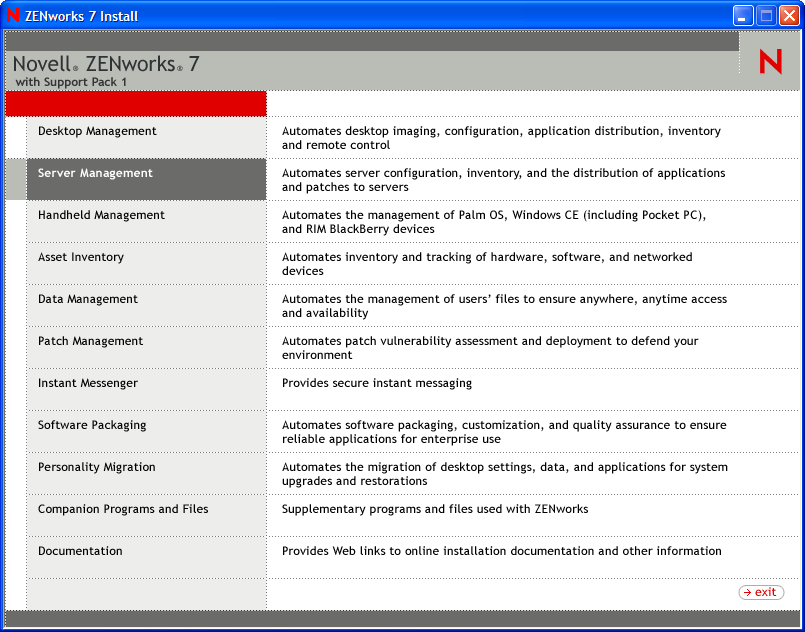
-
Select the option.
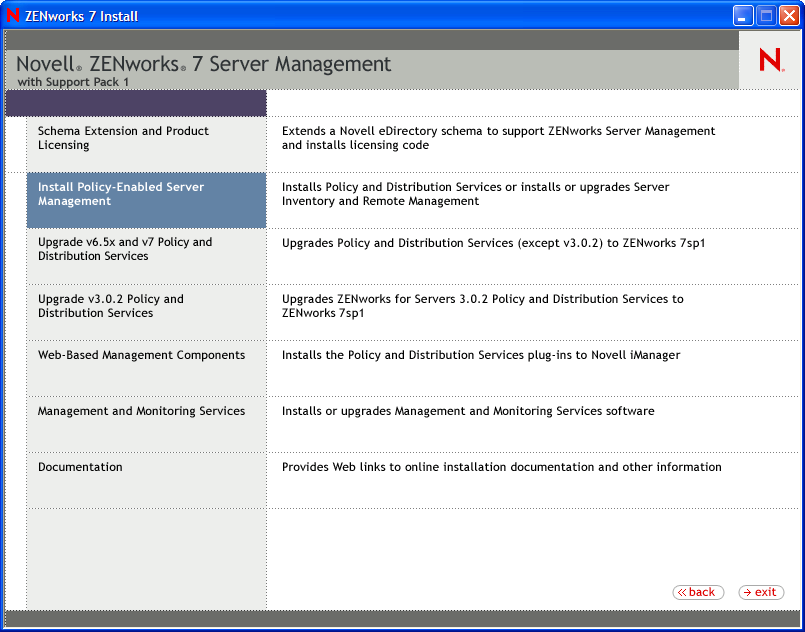
-
Click to start the installation program.
The License Agreement page is the first installation page displayed when the program has loaded.
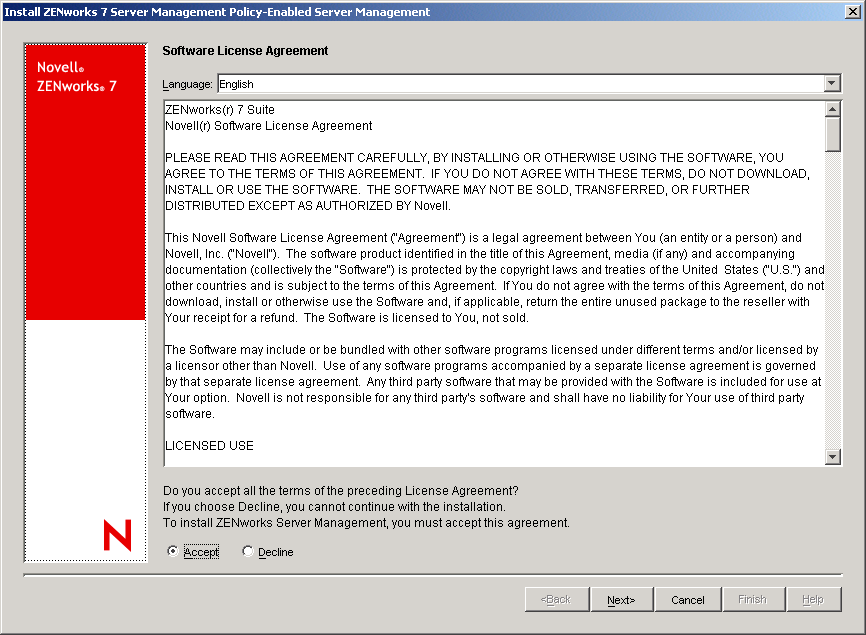
-
If you agree with the Software License Agreement, click , then click to display the Installation Type page; otherwise, click > to exit.
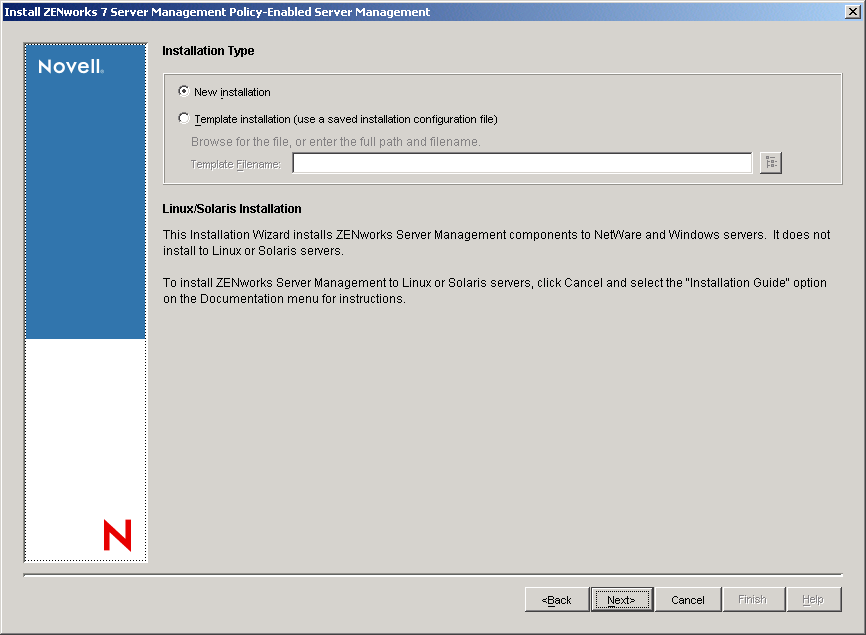
-
On the Installation Type page, click to perform a new installation and display the Installation Options page.
or
To install from a saved installation configuration file, click , browse for or specify the path and the filename, then click .
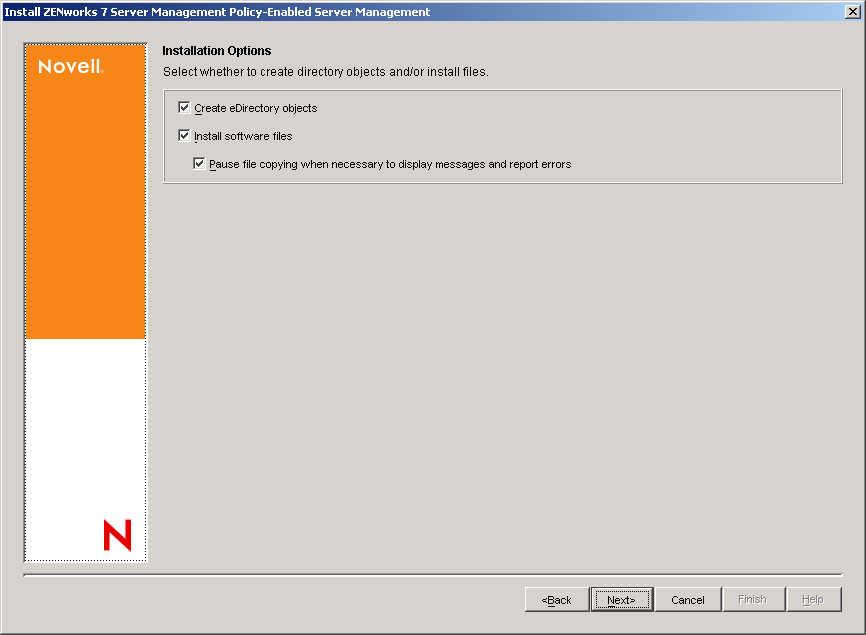
-
On the Installation Options page, configure the installation options, then click .
-
Create eDirectory objects:
-
For a first-time installation, this check box must be selected, unless you want the workstation to act as an External Subscriber.
For more information on External Subscribers, see
External Subscribers
in the Novell ZENworks 7 Server Management Administration Guide. -
Deselect this check box if you only want to reinstall the Subscriber software, such as to a workstation that already has a Subscriber object created for it.
-
Deselect this check box if you only want to install the Subscriber software to a workstation that does not have an object in any eDirectory tree, such as a Windows server that is in a Microsoft domain. You can identify its trusted tree in a later installation page.
-
-
Install software files: Select this option to install the Subscriber software. If you are only installing eDirectory objects, deselect this check box.
-
Pause file copying when necessary to display messages and report errors: By default, this check box is selected. If you want to have an unattended installation (and review the installation logs later), deselect this check box.
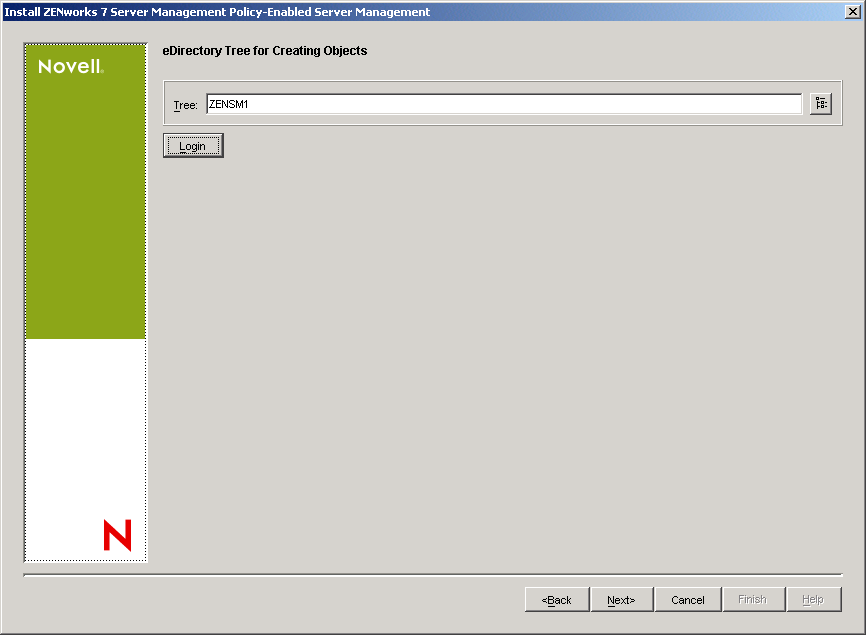
-
-
Browse for and select the target tree, click , then click to display the Server Selection page.
This is the tree where you want the ZENworks objects to be created during installation.
This automatically becomes the trusted tree for all Subscriber workstations selected in the next installation page. The trusted tree provides the Subscriber its configuration updates.
IMPORTANT:If you selected the check box on the Installation Options page, the Windows workstations will have eDirectory Subscriber objects created in the tree that you identified in the eDirectory Tree for Creating Objects page. However, if you deselected this check box, you should identify a trusted tree for each Subscriber in the File Installation Paths and Options page.
On the File Installation Paths and Options page, you can create different configurations for different sets of objects. Therefore, you can select objects that might have different installation paths and different trusted trees.
For more information on trusted trees, see
Subscriber Software Configuration and Trusted Trees
in the Novell ZENworks 7 Server Management Administration Guide.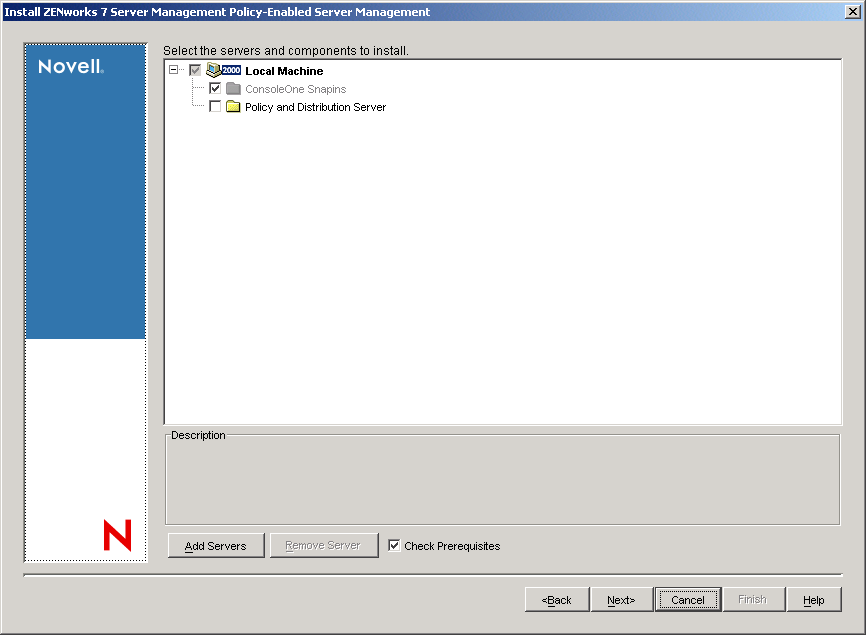
-
If you want to install remotely to one or more workstations, on the Server Selection page, click to display the Add Servers dialog box; otherwise, skip to Step 11.
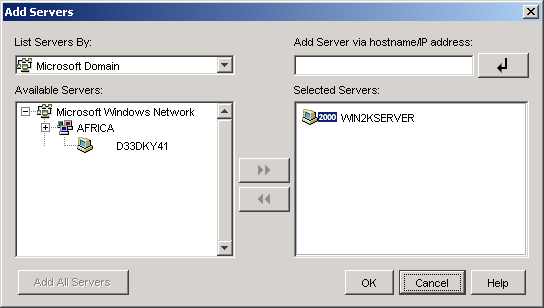
-
In the Add Servers dialog box, do any of the following to select the workstations:
-
Browse for the Windows workstations by selecting the Microsoft domains from a drop-down list.
-
Select workstations individually or in multiples (using Ctrl and Shift).
-
Select groups of workstations by selecting Windows workgroups and Microsoft domains.
-
Specify a workstation by its IP address or DNS name.
Make sure that you have selected all of the Windows workstations before exiting the Add Servers dialog box.
The selected workstations are displayed below the option on the Server Selection page.
For more information on using the Add Servers dialog box, click its button.
-
-
Click to display the Server Selection page:
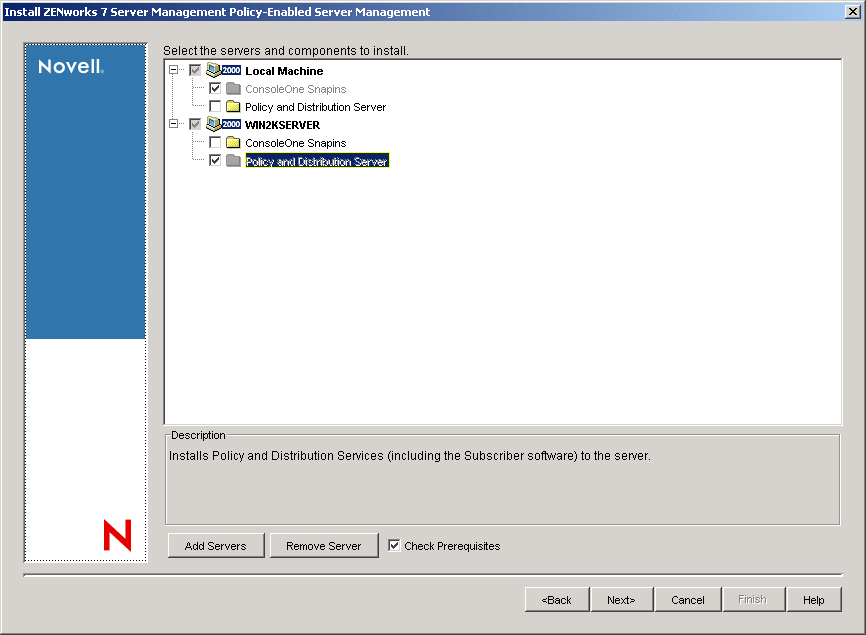
-
Configure the option and each workstation listed on this page.
refers to the Windows machine you are using to perform the remote installation, or the workstation where you are installing Server Management locally.
The following two options are available for the selected workstations and :
-
ConsoleOne snap-ins: Select this check box to install the Policy and Distribution Services snap-ins to the instance of ConsoleOne located on the workstation.
You must have previously installed ConsoleOne 1.3.6 to the workstation.
-
Policy and Distribution Services server: Select this check box to install the Subscriber software on the workstation.
You cannot select and configure a group of workstations. The Custom Selection feature only works with a group of servers.
-
-
When you have finished configuring the selected workstations, click to display the File Installation Locations and Options page.
If you are not installing to a server, a warning is displayed. Click to continue.
If you have invalid DNS names, you could receive an error message asking whether to continue installing using IP addresses. Either fix the DNS name problems, or continue by using IP addresses for the affected workstations. For information on configuring DNS, see Section D.0, Ensuring Successful DNS Name Resolution.
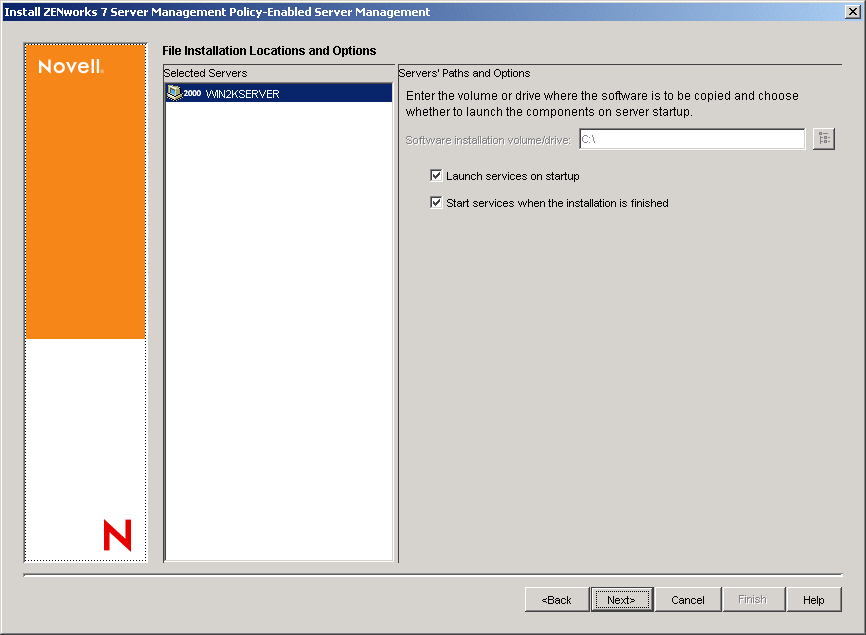
-
Configure the options on the File Installation Locations and Options page:
Software installation volume/drive: If you change the beginning of the path to a different drive, then all subsequent paths displayed in the installation program automatically match your change.
Each field on this page is configurable per workstation. You can make configuration changes individually, or select multiple workstations and make the same configuration changes to all of them. For example, you might want the same installation drive for all of your workstations.
Trusted tree: If you deselected installation of eDirectory objects for ZENworks Server Management, the field is displayed and must be filled in.
When you install the Subscriber software to a workstation in another tree or in a Microsoft domain, and you do not want to create a Subscriber object in your Distributor’s tree, you must identify the trusted tree for the Subscriber workstation.
The trusted tree has two purposes:
-
To locate a Distributor that can give the Tiered Electronic Distribution configuration information to the Subscriber
-
To indicate which tree to accept policies from
If you do not select a tree to be recognized as the Subscriber workstation’s trusted tree during installation of only the Subscriber software (no object installation), your Policy Package Distributions cannot extract and be enforced on that Subscriber workstation, because policies often point to objects in a tree.
Launch Policy and Distribution Services on startup: Leave this check box selected to have the installation program configure the startup processes to automatically launch Policy and Distribution Services any time a workstation is started.
Start services when the installation is finished: Leave this check box selected, because the Subscribers’ passwords are reset when the service starts.
-
-
Click to display the Subscriber Object Properties page:
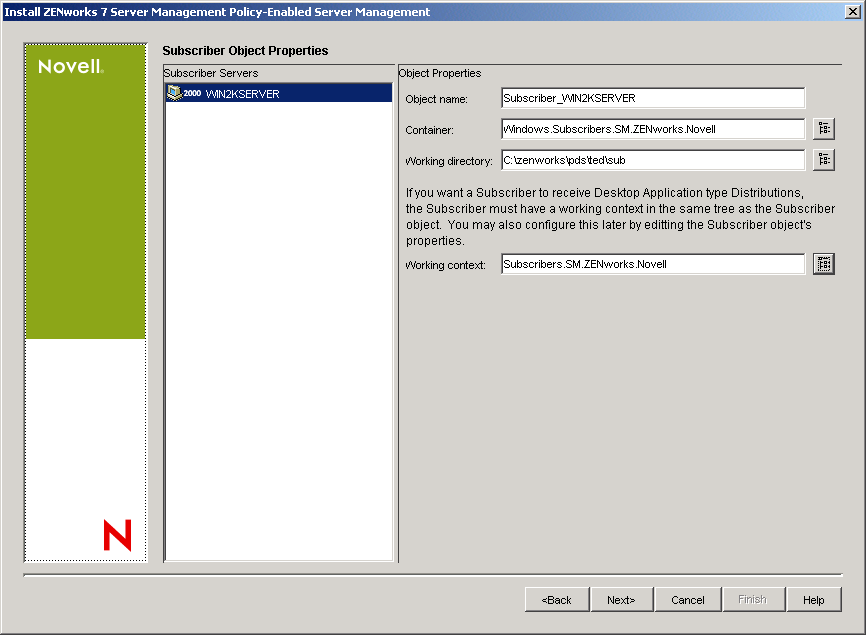
-
Select one or more Subscribers in the left pane, then edit the following fields as necessary:
-
Object name: The default Subscriber object name includes the server’s name.
IMPORTANT:Do not use double-byte or extended characters in object names.
If you want to rename the Subscriber objects, we recommend that you maintain the servers’ identities in their names, including the fact that they are Subscribers.
To rename each Subscriber object, you need to repeat Step 1, because you cannot give the same object name to multiple Subscribers.
-
Container: The location of the Subscriber server’s NCP Server object is the default.
If you have created containers for Subscriber objects, we recommend using these containers (see Section 3.3, eDirectory Container Requirements).
You should use the same context for all Subscriber servers of the same operating system type. For example, place all NetWare Subscriber servers’ objects under a NetWare container and all Windows Subscriber servers’ objects under a Windows container.
Where eDirectory is not installed on a Windows server, that server does not have a default container object displayed. You must select a container for the Subscriber object.
-
Working directory: For NetWare servers, the default working directory is on the sys: volume.
If you change any part of the default path, such as a directory name, and that new entry does not yet exist on the server, the Subscriber creates that new path the first time it needs to use it.
-
Working context: (Optional) If you anticipate Desktop Application Distributions will be received by a Subscriber, browse for and select where you want related objects to be stored.
You can add a working context later in ConsoleOne for any Subscriber that receives Desktop Application Distributions.
-
-
Repeat Step 15 for each different Subscriber or set of Subscribers, then click to display the Database Logging page:
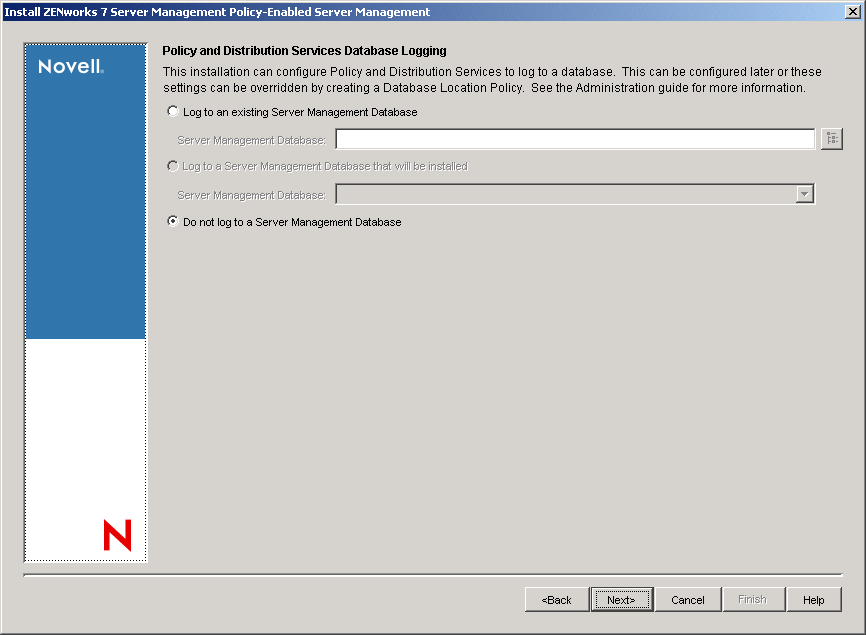
-
To determine logging for a Server Management database that you configured in a previous installation, select one of the following:
Log to an existing Server Management database: Instead of logging data to one of the databases that is being installed, select an existing database file for logging by browsing for and selecting the database object.
Log to a Server Management database that will be installed: This option is not available for a workstation installation of the Subscriber software.
Do not log to a Server Management database: You can elect to not log data to a database at this time, even though you have configured a database in a previous installation.
-
Click to continue with the Installation Summary page:
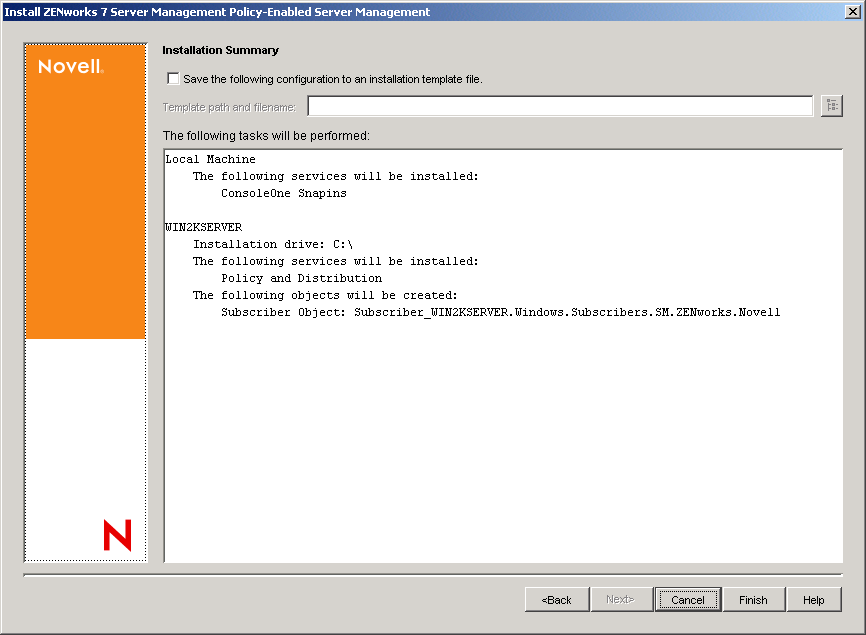
-
To save the current installation configuration for future use, click the check box, then specify a path and filename for the template file.
You can use this template file to repeat the ZENworks Server Management installation. It can save time in re-entering information and re-selecting workstations. When you rerun the installation using a template, you can make changes to the fields and selected workstations in the installation pages that are populated by the template.
-
On the Installation Summary page, click to begin the installation process.
You can click to make changes if you discover errors or omissions in the summary.
-
After the installation program has finished, review the installation log file to determine whether any components failed to install.
The log file is located in the installation machine’s temporary directory as determined in its Windows environment settings. For example:
c:\temp\_resnnn.txtwhere nnn is increased incrementally each time a new installation log is created.
If you receive error messages during installation, see Section H.0, Installation Error Messages.
-
If necessary, rerun the installation program.
Select only the components that failed to install.
-
After successfully installing the software, click to close the main installation program.
At this time, Server Management objects have been created, the software is installed, and the Server Management agents should be starting.
-
To verify that the ZENworks processes are running, go to the target server, open the Control Panel, double-click > , then determine if the Novell ZENworks Service Manager service is running.
If the service is not displayed, do the following:
-
Close the Services window.
-
Click > , then enter the following command:
zenworks\pds\bin\dservices.bat
This stops the ZENworks Server Management services and unregisters them. This is done to make sure a clean state exists for registering the services.
-
Click > , then enter the following command:
zenworks\pds\bin\sservices.bat
This registers the ZENworks Server Management services.
-
Open the Control Panel, double-click > , then start the services by right-clicking each service and selecting the option.
-
-
Repeat Step 24 for each Windows workstation where you installed the Subscriber software.
-
If necessary, rerun the installation program (see Step 1).
-
Continue with the next applicable section:
-
To install the Policy and Distribution Services on Linux or Solaris servers, continue with Section 6.3, Installation on Linux and Solaris Servers.
-
Continue with Section 6.4, Post-Installation Tasks.
-